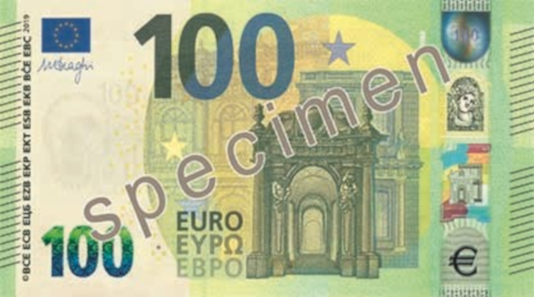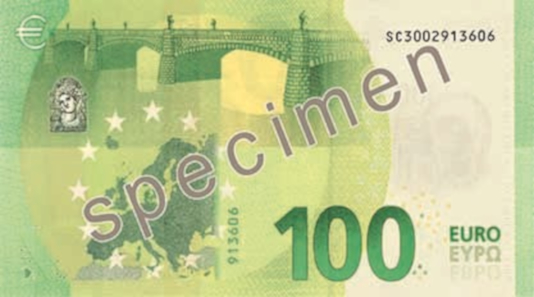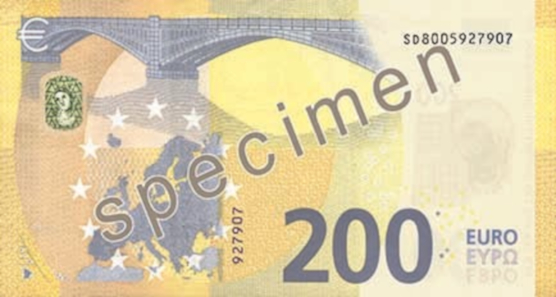by Michael Alexander
October 18, 2018 – The European Central Bank (ECB) unveiled on the 17th September 2018 the two remaining denominations that have undergone an update in terms of design and security features. Begun in 2015 with the €5 banknote, the ECB introduced the new “Europa” series which updated the designs that were in use since the first Euro-denominated banknotes entitled “Ages and styles” and designed by Robert Kalina went into circulation on the 1st January 2002. The unveiling event was once again presided over by Executive Board member Yves Mersch in the European Central Bank’s press office auditorium who personally unveiled the designs of the new €100 and €200 denominations.
100 euros – Green. 147 x 77 mm. Press office of the European Central Bank.
These two denominations are the last values that will undergo an update which were launched to an awaiting news media. Following the €5, €10, €20 and €50, the launch of the €100 and €200 banknotes mark the completion of the updated “Europa” series and will enter circulation on the 28th May 2019. The European Central Bank announced on the 16th May 2016 that they would no longer issue or produce the €500 denomination and as a result, the highest value note would not undergo an update. The “ages and styles” theme of the first series has been continued in the Europa series but has been given a fresh look and stronger colours by the Berlin-based independent banknote designer, Reinhold Gerstetter. He has created visual elements that are more rounded and bridges that are more three-dimensional. These changes make all of the notes included in the ECB’s second series easy to distinguish from the first series. The Europa series also includes security features that are even more difficult to counterfeit than those of the first series.
200 euros – Yellow-Brown. 153 x 77 mm. Press office of the European Central Bank.
The two new 2019-dated notes retain their trademark colours of green for the €100 and yellow for the €200 denomination but one significant change for these notes is that they will now be a different size to the first series €100 and €200 notes. Both denominations are now the same height as the €50 banknote with their length remaining unchanged – the longer the note, the higher the value. Since the €50, €100 and €200 banknotes are now the same height, this alteration means they can be more easily handled and processed by machines. They will also fit better in people’s wallets and last longer as they will be subject to less wear and tear. The signature of both banknotes will include that of ECB President Mario Draghi, in office since 2011 and whose term is to expire in November 2019.
Yves Mersch unveils new 100 euros Europa series. Photo: Press office of the European Central Bank.
The new €100 and €200 banknotes make use of new and innovative security features. Just like the other denominations, these new notes are easy to check when using the “feel, look and tilt” method first introduced with the earlier EURO banknote series. At the top of the silvery stripe is a satellite hologram which shows small € symbols that move around the note’s numeric value and become clearer under direct light. The silvery stripe also shows the portrait of Europa, the architectural motif and a large € symbol. The new €100 and €200 banknotes also feature an enhanced emerald number which can be seen to the lower left as seen from the front side of the notes. While the emerald number itself is present on all the other notes of the Europa series, this enhanced version also shows € symbols inside the numerals.
In addition to the security features that can be seen by ordinary glance, the EURO banknotes also contain machine-readable security features. On the new €100 and €200 banknotes these features have been enhanced, and new ones have been added to enable the notes to be processed and authenticated swiftly. As Executive Board Member Yves Mersch highlighted in his speech unveiling the new banknotes, with the changeover to the new €100 and €200 the entire set of euro banknotes will continue to offer strong protection against counterfeiting. This makes euro banknotes even more secure, but also easier to check and handle.
Included / updated security elements:
Portrait window
When viewing the banknote against the light, the window in the hologram on the right becomes transparent and reveals a portrait of Europa on both sides of the note.
Portrait watermark
By holding the banknote against the light, an image of Europa, a copy of the main image and the value of the banknote appear on the left in the watermark field.
Satellite hologram
The satellite hologram is a feature unique to the €100 and €200 notes and is located at the top of the silvery vertical stripe. When the banknote is tilted, it shows tiny € symbols that move around the number. Those symbols become clearer under direct light.
Emerald number
When the banknote is tilted, the shiny number in the bottom-left corner on the obverse or front side changes colour from emerald green to deep blue and displays an effect of the light that moves up and down. The new €100 and €200 banknotes also show tiny € symbols inside the number.
Euro banknotes in the first or “Ages of Europe” series remain legal tender and can be used or exchanged for current series banknotes any time without time limit and at any bank which is part of the Euro-system.
The author, Michael Alexander is president of the London Banknote and Monetary Research Centre.
For more information on this and the previous series of Euro banknotes, please visit the website of the European Central Bank.
A video explaining the new security features in detail is available on YouTube.








